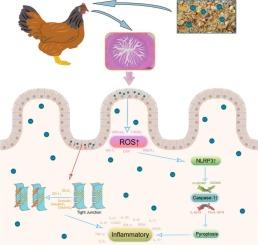Unveiling excessive feed-sources copper-induced ileitis in chickens: Insights into tight junction damage and ROS/NLRP3/pyroptosis axis
IF 4.3
3区 环境科学与生态学
Q2 BIOCHEMISTRY & MOLECULAR BIOLOGY
Comparative Biochemistry and Physiology C-toxicology & Pharmacology
Pub Date : 2025-09-13
DOI:10.1016/j.cbpc.2025.110357
引用次数: 0
Abstract
Copper, widely used as a growth promoter and antibacterial agent, is commonly added to livestock and poultry feed. However, this widespread use leads to its accumulation in the animals' bodies, resulting in intestinal toxicity. The specific mechanisms of copper-induced ileitis in broilers remain unclear. In this study, broilers were fed diets containing 0, 100, or 300 mg/kg CuSO₄ over a five-week period. Results showed that the high‑copper group (300 mg/kg) exhibited significant suppression of antioxidant defenses, including reduced heme oxygenase-1 (HO-1), NAD(P)H quinone dehydrogenase 1 (NQO1), total superoxide dismutase (SOD), and glutathione peroxidase (GSH-Px) levels, while catalase (CAT) activity was paradoxically elevated. Notably, NOD-like receptor family pyrin domain containing 3 (NLRP3) inflammasome complex activation (NLRP3, apoptosis-associated speck-like protein containing a CARD [ASC], Caspase-1) and upregulated pyroptosis markers (Caspase-1, interleukin-1β [IL-1β]) indicated reactive oxygen species (ROS)–NLRP3 axis involvement. Concurrently, pro-inflammatory mediators (interleukin-7 [IL-7], interleukin-17 [IL-17], inducible nitric oxide synthase [iNOS], tumor necrosis factor-α [TNF-α]) were dysregulated, accompanied by diminished expression of tight junction proteins (zonula occludens-1 [ZO-1], Claudin-3, Occludin) and inhibition of the Wnt/β-catenin pathway. These findings demonstrate that copper-induced intestinal inflammation and pyroptosis are driven by ROS–NLRP3 axis activation, while simultaneously compromising mucosal barrier integrity. This study elucidates critical mechanisms of copper toxicity in broilers and highlights risks associated with excessive copper exposure.

揭示过量饲料来源铜诱导的鸡回肠炎:对紧密连接损伤和ROS/NLRP3/焦亡轴的见解。
铜被广泛用作生长促进剂和抗菌剂,通常添加到畜禽饲料中。然而,这种广泛使用导致其在动物体内积累,导致肠道毒性。铜诱发肉鸡回肠炎的具体机制尚不清楚。在本研究中,肉鸡在5周内分别饲喂含有0、100或300 mg/kg硫酸铜的饲粮。结果表明,高铜组(300 mg/kg)显著抑制了抗氧化防御,包括血红素氧化酶-1 (HO-1)、NAD(P)H醌脱氢酶1 (NQO1)、总超氧化物歧化酶(SOD)和谷胱甘肽过氧化物酶(GSH-Px)水平降低,而过氧化氢酶(CAT)活性却升高。值得注意的是,nod样受体家族pyrin结构域包含3 (NLRP3)炎性体复合物激活(NLRP3,凋亡相关斑点样蛋白含有CARD [ASC], Caspase-1)和上调的焦亡标志物(Caspase-1,白细胞介素-1β [IL-1β])表明活性氧(ROS)-NLRP3轴参与。同时,促炎介质(白细胞介素-7 [IL-7]、白细胞介素-17 [IL-17]、诱导型一氧化氮合酶[iNOS]、肿瘤坏死因子-α [TNF-α])出现异常,并伴有紧密连接蛋白(闭塞带-1 [ZO-1]、Claudin-3、Occludin)表达减少,Wnt/β-catenin通路受到抑制。这些发现表明,铜诱导的肠道炎症和焦亡是由ROS-NLRP3轴激活驱动的,同时损害了粘膜屏障的完整性。本研究阐明了肉仔鸡铜中毒的关键机制,并强调了过量铜暴露的相关风险。
本文章由计算机程序翻译,如有差异,请以英文原文为准。
求助全文
约1分钟内获得全文
求助全文
来源期刊
CiteScore
7.50
自引率
5.10%
发文量
206
审稿时长
30 days
期刊介绍:
Part C: Toxicology and Pharmacology. This journal is concerned with chemical and drug action at different levels of organization, biotransformation of xenobiotics, mechanisms of toxicity, including reactive oxygen species and carcinogenesis, endocrine disruptors, natural products chemistry, and signal transduction with a molecular approach to these fields.

 求助内容:
求助内容: 应助结果提醒方式:
应助结果提醒方式:


